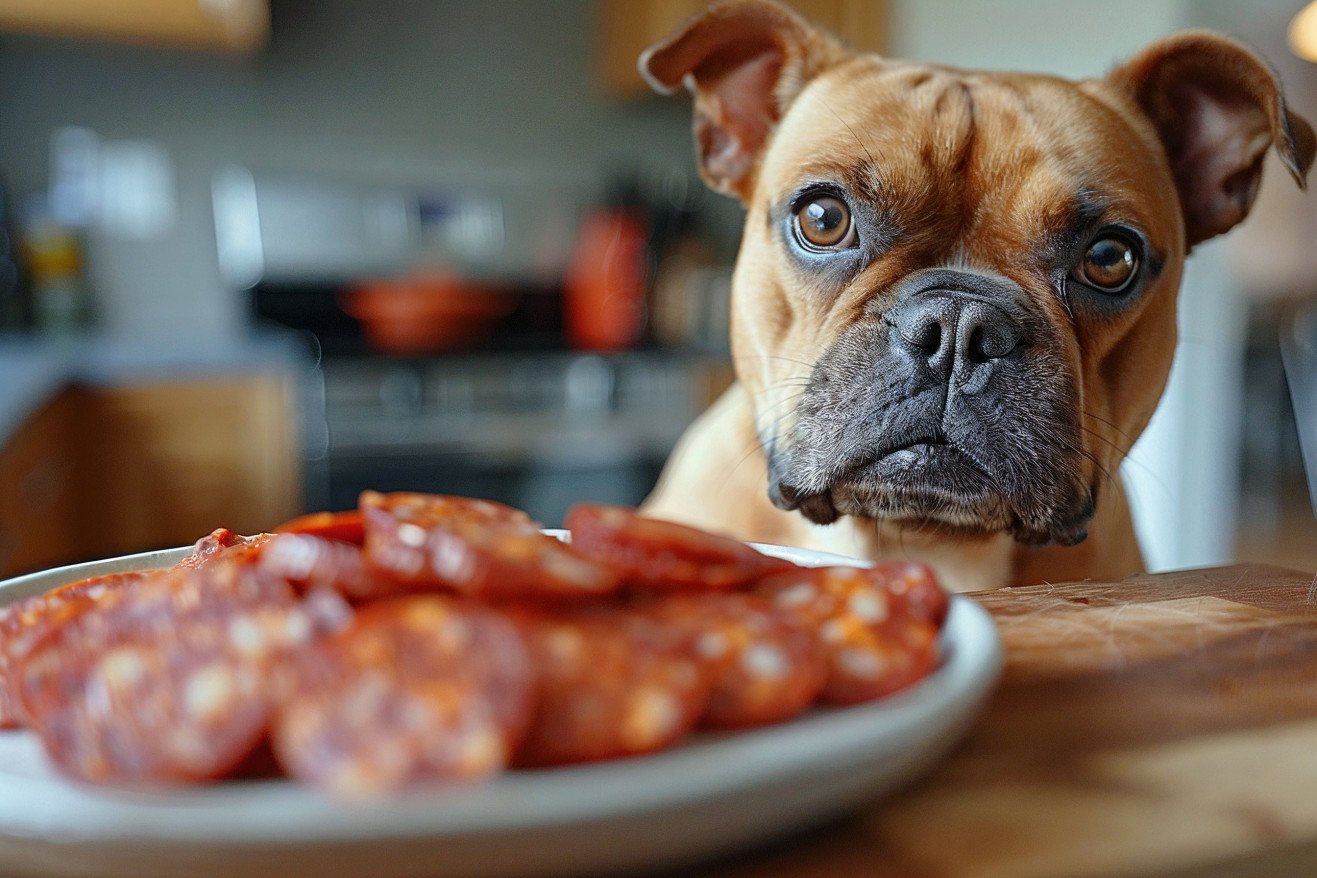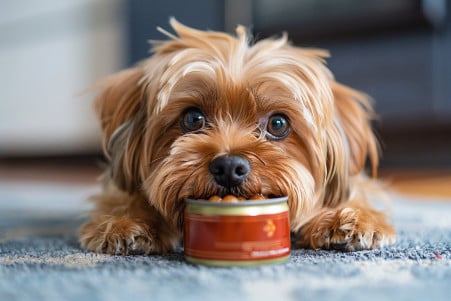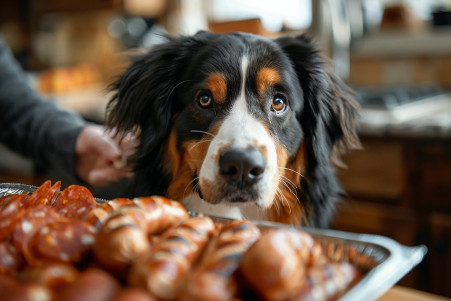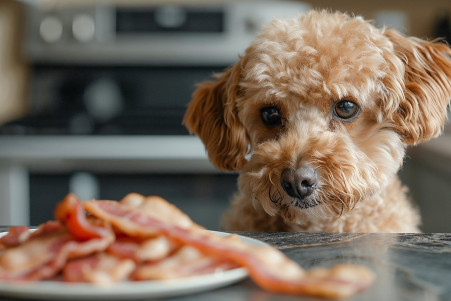Can Dogs Eat Chorizo? Understanding the Risks to Canine Health
1 March 2024 • Updated 29 February 2024

Are you thinking about sharing some of your delicious chorizo with your dog? Think again. Chorizo is not safe for dogs and can cause a number of health issues, including obesity, pancreatitis, heart disease, and salt poisoning. In addition to being high in fat and salt, chorizo often contains spices and other ingredients that are toxic to dogs, like onions and garlic.
This article will review the latest veterinary research and dietary recommendations to help you better understand the health risks associated with giving your dog foods like chorizo. We will cover everything from the latest research on canine nutrition and the impact of fats and sodium to the dangers of dogs consuming the spices and other additives in human sausages.
After reading this article, you will have the information you need to make the best choices for your dog’s diet and treats.
Can dogs eat chorizo?
Understanding the Impact of High-Fat Diets in Dogs
The impact of high-fat diets, including those that include chorizo, on dogs is significant. A study published in PMC found that high-fat diets can change the blood metabolites in dogs. Most notably, a high-fat diet can increase blood glucose and insulin ratios, which indicates the potential for changes in glucose metabolism.
This is a result of feeding dogs high-energy diets, which can lead to chronic health conditions like obesity and pancreatitis, both of which are common in dogs that have been fed high-fat diets.
The study also found that the fecal microbiota was different in dogs that were fed high-fat and high-starch diets. Similarly, a study published in PMC found that a high-fat diet changes the bacteria in a dog’s fecal samples, but that this change isn’t necessarily harmful as long as the rest of the dog’s diet is well-balanced.
That said, Frontiers in Veterinary Science points out that there are dangers to consuming too much fat, noting that the overconsumption of high-fat foods is a major contributor to canine obesity. This makes it important to understand the balance and impact of dietary fats on dogs, especially when it comes to treats like chorizo that are a long way from what dogs would eat in the wild.
Why Sodium Is Important and Dangerous in Your Dog’s Diet
Sodium is important for your dog’s overall health, helping to balance body fluids and maintain healthy organ and nerve function. However, the American Kennel Club points out that while it is an essential electrolyte, too much sodium can lead to hypernatremia or salt toxicosis, which are conditions that occur when there is too much sodium in the blood.
Symptoms of salt poisoning in dogs include vomiting, diarrhea, seizures, and increased thirst and urination. The Pet Poison Helpline warns that salt poisoning can be life-threatening, with symptoms progressing to tremors, seizures, and even coma. In small dogs, as little as 2–3 grams of sodium chloride per kilogram of body weight can be toxic.
Veterinarians recommend that dogs’ sodium intake be kept in check. Hill’s Pet explains that it’s especially important to monitor the amount of salt in your dog’s diet if they are older or have heart or kidney disease because too much salt can make their conditions worse.
Dogs that eat high-sodium foods like chorizo can put their health at risk, so it’s important to carefully monitor their diet to make sure they don’t experience any negative side effects.
Breaking Down the Dangers of Chorizo for Dogs
The dangers of chorizo for dogs are largely due to the toxic ingredients that give the sausage its distinctive flavor. Onion and garlic, both of which are part of the Allium family, are staples in chorizo recipes and are known to cause oxidative damage to red blood cells, which can lead to anemia in dogs.
ASPCA explains that even small amounts of these ingredients can cause gastrointestinal irritation and red blood cell damage in dogs. Signs of toxicity from these ingredients can include vomiting, weakness, and difficulty breathing.
Other ingredients in chorizo, like the high salt content and spices, also make it a poor choice for dogs. Too much salt can lead to sodium ion poisoning, which can cause symptoms like diarrhea, tremors, and seizures, according to ASPCA. In addition, the spices that are often used in chorizo can also be problematic and lead to severe gastrointestinal upset.
If your dog eats chorizo by accident, it’s important to monitor them for signs of distress. You should also contact your veterinarian or the ASPCA Animal Poison Control Center immediately. Early detection and intervention with these toxins are important to minimize the impact they have on your pet. Knowing the dangers of human foods like chorizo can help dog owners keep their pets safe.
What to Do If Your Dog Eats Chorizo
If your dog has eaten chorizo or any other potentially toxic food, you need to act quickly. First, assess your dog’s condition to make sure they are breathing normally and not showing any signs of distress, including vomiting, diarrhea, excessive drooling, or seizures, according to Daily Paws.
If your dog is showing any of these signs or you suspect that they have eaten something toxic, call your vet or an emergency animal hospital immediately.
If you can’t get ahold of a vet, the Cornell University College of Veterinary Medicine suggests calling the ASPCA 24/7 Poison Control Hotline or the Pet Poison Helpline. They can help you determine if it is safe to induce vomiting with 3% hydrogen peroxide, which is a critical step in preventing the body from absorbing the toxins.
When a dog has been poisoned, vets often induce vomiting and give the dog activated charcoal to prevent the body from absorbing the toxins, according to Cornell’s College of Veterinary Medicine. It’s important to monitor your dog closely, especially for signs of pancreatitis, which can occur after a dog eats a high-fat food like chorizo, according to VETSS.
In these situations, it’s important to get your dog to a vet so that they can be treated by a professional who can ensure that they are safe and healthy. As you work through this situation, make sure that you remember to keep toxic foods out of your dog’s reach and stay vigilant to prevent future incidents.
Healthy Alternatives to Feeding Your Dog Chorizo
When it comes to treating your dog, it’s important to choose options that are safe and healthy.
Instead of chorizo, you can opt for carrots, which are low in calories and have a satisfying crunch, while also being high in beta-carotene and vitamin A.
You can also choose apples (without the core and seeds), which are also high in vitamins A and C. If you’re looking for a protein, cooked salmon is a great option, as it’s high in Omega-3 fatty acids, which are great for skin and coat health. Just be sure to feed these treats in moderation to avoid adding too many calories to your dog’s diet. In general, treats should make up no more than 10% of your dog’s daily caloric intake.
When you’re introducing new treats, make sure to do so slowly and watch your dog for any signs of stomach upset. For example, while pumpkin can be good for your dog’s digestive health, it’s best to start with small amounts.
Also, make sure to cut treats into pieces that are an appropriate size for your dog to avoid a choking hazard. NBC News recommends making sure that the size of the treat is in proportion to the size of your dog and avoiding treats that contain artificial sweeteners or too much salt.
By following these tips and making sure that you’re always putting your dog’s health first, you can make sure that treat time is both fun and beneficial, and that the treats you’re offering are helping to contribute to your dog’s overall health.
Final Thoughts: Chorizo and Your Dog’s Health
To sum up, chorizo is a danger to dogs because of its high-fat, salt, and spice content. These ingredients can cause a range of health problems, including obesity, pancreatitis, heart disease, and salt poisoning. When you add in the toxic effects of onion and garlic, chorizo becomes an even bigger threat to dogs.
It is important for pet owners to be aware of their dog’s dietary needs. As mentioned above, the best way to treat your dog while keeping them healthy is to choose healthy, dog-friendly options. This will not only satisfy their palate but also help them live longer and healthier lives.
It is up to pet owners to be aware of the dangers of human food and to choose treats that will meet their dog’s nutritional needs. By making sure that our dogs are eating food that is both safe and satisfying, we are showing that we are committed to their well-being.


